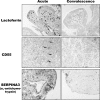Broad up-regulation of innate defense factors during acute cholera
- PMID: 17307946
- PMCID: PMC1865766
- DOI: 10.1128/IAI.01900-06
Broad up-regulation of innate defense factors during acute cholera
Abstract
We used a whole-genome microarray screening system (Affymetrix human GeneChips covering 47,000 different transcripts) to examine the gene expression in duodenal mucosa during acute cholera. Biopsies were taken from the duodenal mucosa of seven cholera patients 2 and 30 days after the onset of diarrhea, and the gene expression patterns in the acute- and convalescent-phase samples were compared pairwise. Of about 21,000 transcripts expressed in the intestinal epithelium, 29 were defined as transcripts that were up-regulated and 33 were defined as transcripts that were down-regulated during acute cholera. The majority of the up-regulated genes characterized were found to have an established or possible role in the innate defense against infections; these genes included the LPLUNC1, LF, VCC1, TCN1, CD55, SERPINA3, MMP1, MMP3, IL1B, LCN2, SOCS3, GDF15, SLPI, CXCL13, and MUC1 genes. The results of confirmative PCR correlated well with the microarray data. An immunohistochemical analysis revealed increased expression of lactoferrin in lamina propria cells and increased expression of CD55 in epithelial cells, whereas increased expression of the SERPINA3 protein (alpha1-antichymotrypsin) was detected in both lamina propria and epithelial cells during acute cholera. The expression pattern of CD55 and SERPINA3 in cholera toxin (CT)-stimulated Caco-2 cells was the same as the pattern found in the intestinal mucosa during acute cholera, indicating that the activation of the CD55 and SERPINA3 genes in intestinal epithelium was induced by CT. In conclusion, during acute cholera infection, innate defense mechanisms are switched on to an extent not described previously. Both direct effects of CT on the epithelial cells and changes in the lamina propria cells contribute to this up-regulation.
Figures




Similar articles
-
Bacterial-associated cholera toxin and GM1 binding are required for transcytosis of classical biotype Vibrio cholerae through an in vitro M cell model system.Cell Microbiol. 2006 Jun;8(6):982-98. doi: 10.1111/j.1462-5822.2005.00681.x. Cell Microbiol. 2006. PMID: 16681839
-
Differential expression of intestinal membrane transporters in cholera patients.FEBS Lett. 2007 Jul 10;581(17):3183-8. doi: 10.1016/j.febslet.2007.06.001. Epub 2007 Jun 12. FEBS Lett. 2007. PMID: 17575980
-
Transcriptional upregulation of inflammatory cytokines in human intestinal epithelial cells following Vibrio cholerae infection.FEBS J. 2007 Sep;274(17):4631-42. doi: 10.1111/j.1742-4658.2007.05991.x. Epub 2007 Aug 14. FEBS J. 2007. PMID: 17697117
-
Microbial-host interactions at mucosal sites. Host response to pathogenic bacteria at mucosal sites.Curr Top Microbiol Immunol. 1999;236:163-89. doi: 10.1007/978-3-642-59951-4_9. Curr Top Microbiol Immunol. 1999. PMID: 9893360 Review. No abstract available.
-
The acute infectious diarrhoeas as diseases of the intestinal mucosa.J Diarrhoeal Dis Res. 1997 Dec;15(4):224-31. J Diarrhoeal Dis Res. 1997. PMID: 9661318 Review.
Cited by
-
Biofilm formation on human immune cells is a multicellular predation strategy of Vibrio cholerae.Cell. 2023 Jun 8;186(12):2690-2704.e20. doi: 10.1016/j.cell.2023.05.008. Epub 2023 Jun 8. Cell. 2023. PMID: 37295405 Free PMC article.
-
Human LPLUNC1 is a secreted product of goblet cells and minor glands of the respiratory and upper aerodigestive tracts.Histochem Cell Biol. 2010 May;133(5):505-15. doi: 10.1007/s00418-010-0683-0. Epub 2010 Mar 18. Histochem Cell Biol. 2010. PMID: 20237794 Free PMC article.
-
Analysis of IL12B gene variants in inflammatory bowel disease.PLoS One. 2012;7(3):e34349. doi: 10.1371/journal.pone.0034349. Epub 2012 Mar 30. PLoS One. 2012. PMID: 22479607 Free PMC article.
-
Comparative proteomic analysis reveals activation of mucosal innate immune signaling pathways during cholera.Infect Immun. 2015 Mar;83(3):1089-103. doi: 10.1128/IAI.02765-14. Epub 2015 Jan 5. Infect Immun. 2015. PMID: 25561705 Free PMC article.
-
An Update on Cholera Immunity and Current and Future Cholera Vaccines.Trop Med Infect Dis. 2021 Apr 28;6(2):64. doi: 10.3390/tropicalmed6020064. Trop Med Infect Dis. 2021. PMID: 33925118 Free PMC article.
References
-
- Arnold, R. R., M. F. Cole, and J. R. McGhee. 1977. A bactericidal effect for human lactoferrin. Science 197:263-265. - PubMed
-
- Bingle, C. D., and C. J. Craven. 2002. PLUNC: a novel family of candidate host defence proteins expressed in the upper airways and nasopharynx. Hum. Mol. Genet. 11:937-943. - PubMed
-
- Bootcov, M. R., A. R. Bauskin, S. M. Valenzuela, A. G. Moore, M. Bansal, X. Y. He, H. P. Zhang, M. Donnellan, S. Mahler, K. Pryor, B. J. Walsh, R. C. Nicholson, W. D. Fairlie, S. B. Por, J. M. Robbins, and S. N. Breit. 1997. MIC-1, a novel macrophage inhibitory cytokine, is a divergent member of the TGF-beta superfamily. Proc. Natl. Acad. Sci. USA 94:11514-11519. - PMC - PubMed
-
- Borregaard, N., and J. B. Cowland. 1997. Granules of the human neutrophilic polymorphonuclear leukocyte. Blood 89:3503-3521. - PubMed
-
- Bromander, A., J. Holmgren, and N. Lycke. 1991. Cholera toxin stimulates IL-1 production and enhances antigen presentation by macrophages in vitro. J. Immunol. 146:2908-2914. - PubMed
Publication types
MeSH terms
Substances
LinkOut - more resources
Full Text Sources
Medical
Molecular Biology Databases
Research Materials
Miscellaneous

